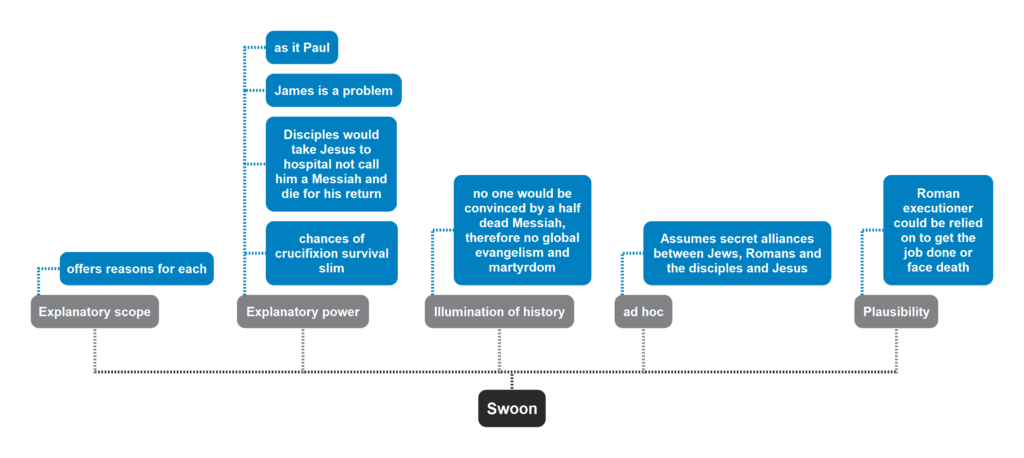7.3 Apparent death theory (swoon)

Explanatory scope
The apparent death theory also provides explanations for the empty tomb, postmortem appearances, and origin of the disciples’ belief in Jesus’ resurrection.
Explanatory power
Here the theory begins to crumble. Some versions of the apparent death theory were really variations on the conspiracy theory. Instead of stealing the body, the disciples (along with Jesus Himself!) were supposed to have conspired to fake Jesus’ death on the cross. In such cases, the theory shares all the weaknesses of the conspiracy theory. A non-conspiratorial version of the theory was that Jesus just happened to survive the crucifixion, though the guards thought He was dead. Such a version of the theory is also saddled with overwhelming difficulties: How do you explain the empty tomb, since a man sealed inside a tomb could not move the stone so as to escape? How do you explain the postmortem appearances, since the appearance of a half-dead man desperately in need of medical attention would hardly have elicited in the disciples the conclusion that He was the risen Lord and conqueror of death? How do you explain the origin of the disciples’ belief in Jesus’ resurrection, since seeing Him again would lead them to conclude merely that He hadn’t died? They wouldn’t think that He was, contrary to Jewish thought (as well as their own eyes), gloriously risen from the dead.
Illumination of history
Certainly if he didn’t die we would still have an empty tomb. The disciples however, would not have been convinced by a bloodied but unglorified Messiah. They would spend the next 40 years dying for and claiming he rose from the dead, at least one is likely to buckle like every cult in history involving primary eyewitnesses. As well as this, James and Paul would not lead the church around europe the way they did unless Jesus had risen from the dead. Historically, it’s a non-starter because the figures to begin the Christian revolution would not be there, more likely they would laugh from a distance and Judaism would continue on as normal, patiently waiting for their real Messiah.
Less ad hoc
The apparent death theory, especially in its conspiratorial versions, can become enormously contrived. We’re invited to imagine secret societies, stealthily administered potions, conspiratorial alliances between Jesus’ disciples and members of the Sanhedrin, and so forth, all without a shred of evidence in support.
Plausibility
Here again the theory fails miserably. Roman executioners could be relied upon to ensure that their victims were dead. Since the exact moment of death by crucifixion is uncertain, executioners could ensure death by a spear thrust into the victim’s side. This is what happened to Jesus (John 19:34). Moreover, what the theory suggests is virtually physically impossible. The Jewish historian Josephus tells of how he had three acquaintances who had been crucified removed from their crosses, but despite the best medical attention two of the three died anyway (Josephus, Life 75:420–21). The extent of Jesus’ tortures prior to crucifixion was such that He could never have survived the crucifixion and entombment. The suggestion that a man so critically wounded then went on to appear to the disciples on various occasions in Jerusalem and Galilee is pure fantasy.




0 Comments